If you are planning an event or gathering, consider making this Salmagundi board for serving up your guests.
An arrangement of fresh fruit, eggs, vegetables, meats, and more.
The ultimate grazing board offers a stunning presentation and a delicious spread to nibble on.
There are snacking items for everyone on this salmagundi board.
A Salmagundi Board – The First Charcuterie Board
We’ve been making charcuterie boards and grazing platters for several years now.
But did you know this type of food platter board already existed under a different name?
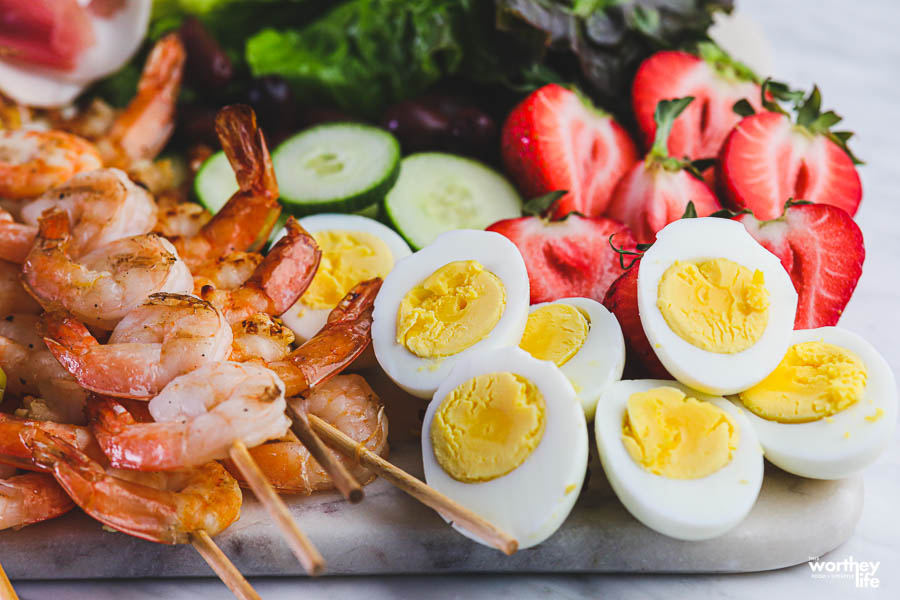
What is a Salmagundi Board?
A salmagundi board comprises an assortment of meats (meat is optional), hard-boiled eggs, and a collection of vegetables and finger foods like olives, nuts, and other savories.
At first glance, it is an offering that is appealing to the eyes.
The contrasting colors of the foods play a big part in a salmagundi board.
The foods should plate well together, with lots of green and other complimentary colors.
Think of a seasonal, fresh, savory, crisp, and delicious approach!

Word Origin
The word salmagundi is a derivative of the 16th-century French work salmigondis, roughly translated as an assembly of things, ideas or people, etc.
A cornucopia of items that forms an incoherent whole.
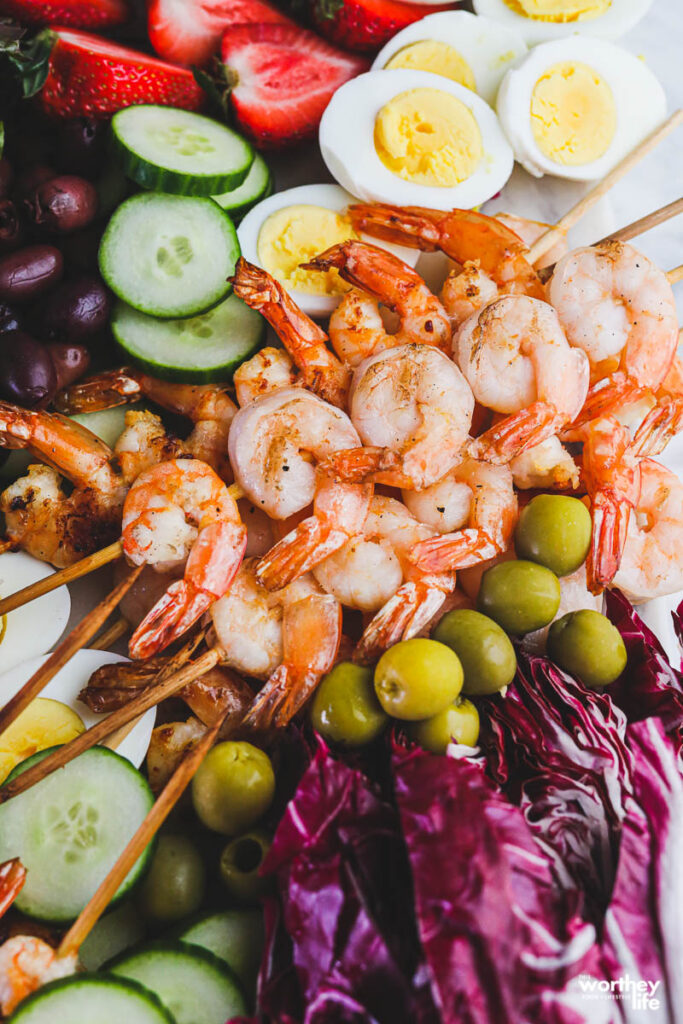
What You Will Need
Our version of a Salmagundi Board contains seafood and sliced preserved meats, fresh garden veggies, hard-boiled eggs, sweet strawberries, and brined olives.
Meats. For our board, I used prosciutto but other Italian cured meats like guanciale, speck, and lardo. Adding cured meats like fennel or truffled salami and sweet soppressata or hot soppressata is a great way to add a bit of variety to your salmagundi board. Switch up the cured meats by adding French varieties like a quality saucisson—a dry-cured, fermented salami or a thinly sliced specialty ham like Jambon or, more specifically, a Jambon de Paris. But thinly sliced roast beef or country ham also works in meats!
Lettuce. Try adding radicchio or speckled lettuce to add a bit of color contrast. When it comes to lettuce on your salmagundi board, I lean towards crispy varieties like romaine, arugula, butterhead, and endive; all work well.
Cucumbers. I love using cucumbers for this recipe because they are crisp and clean palette. I prefer English cucumbers because the seeds are smaller and have a slight sweetness compared to other varieties.
Hard-Boiled Eggs. A typical salmagundi board will have hard-boiled eggs. I love switching things up by adding hard-boiled duck eggs. Don’t do eggs? No biggie. A well-prepared salmagundi good can be equally yummy with or without animal proteins.
Skewered Shrimp. Adding shrimp is often a good way to take a dish from good to great! I skewered shrimp and grilled them with melted garlic butter and honey. So good!
Strawberries and peaches. Summertime strawberries are the best, and I usually favor the smaller varieties of strawberries because they are the sweetest and pack the most flavor. We’re also using sweet, juicy Georgia peaches.
Olives. Give me olives, and everything will be alright! When it comes to olives, I prefer them pitted, and I like to mix different kinds of olives like Kalamata, bright green, or black varieties!
Ingredients:
- 2 packages of prosciutto
- 1 head of oak leaf lettuce, pulled apart or chopped
- 6 hard-boiled eggs, then cut in half
- 20 shrimp (five per skewer) raw shrimp with the heads removed, or use precooked shrimp
- 1 cup of strawberries
- 1 large English cucumber, cut into small rounds
- 1/2 cup pitted green olives
- 1/2 pitted black olives
- 1 stick of unsalted butter
- 2 tbsp of honey
- 3 cloves of garlic, minced
- freshly cracked black peppercorns to taste
- sea salt to taste
Directions:
- Melt the butter and add honey and minced garlic. Set aside.
- Devein the shrimp and, remove the heads, slide the shrimp onto the wooden skewers.
- Cook the shrimp on a stovetop grill pan or outdoor grill over medium-high heat, divide the butter mixture, baste the shrimp skewers with the prepared honey garlic butter, and season to taste with freshly cracked black peppercorns or sea salt. Serve the shrimp with the remaining honey garlic butter.
- Boil eggs and allow them to cool; when eggs are safe to handle, cut them in half.
- Place the hard-boiled eggs, shrimp skewers, and lettuce on a serving board.
- Arrange the remaining prosciutto, strawberries, cucumbers, and green and black olives around the board.
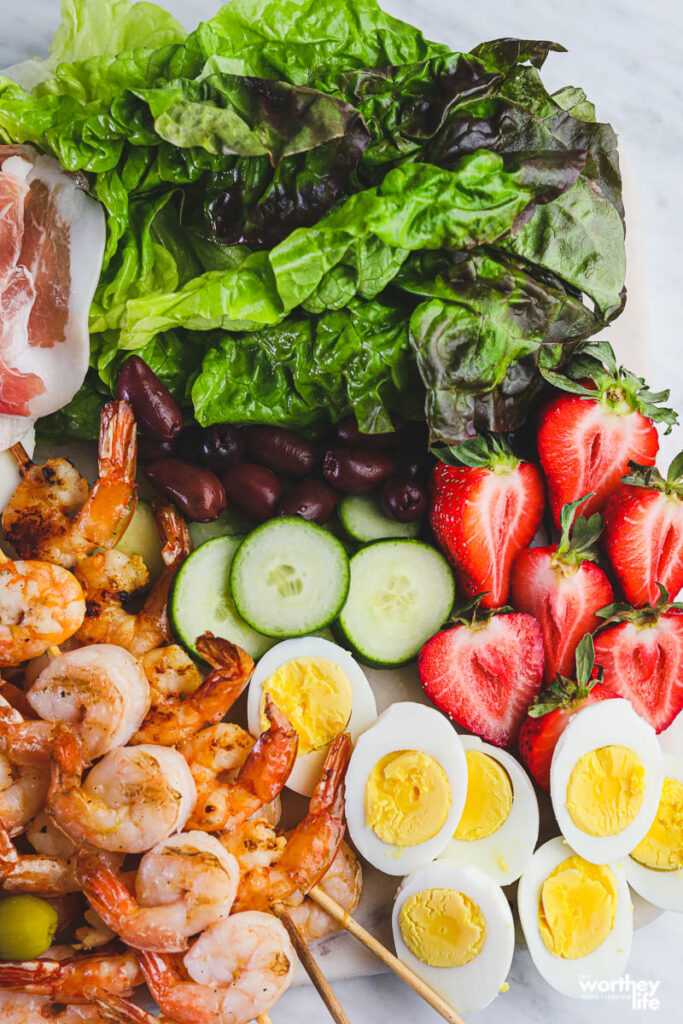
Additional Options:
Meats
- thinly sliced lamb, sliced roasted chicken or turkey, or smoked pork
Seafood
- scallops, crab, lobster claws, oysters, or crayfish, deep-fried calamari
Vegetables
A rule of thumb is to use what is in season, so depending on the time of year, your salmagundi board will reflect the foods that are in season and readily available.
- Carrots, peppers, eggplant, tomatoes, squash, green onion, spinach, swiss chard, etc.
Fruits
Again, choose what is in season, and you will be fine.
- sliced peaches, orange sections, sliced and quartered apples, pears, plums, apricots, melons, pitted cherries
Can I add different dips or spreads to the board?
You could add a cocktail sauce for dipping shrimp and other seafood.
I like having spicy mustard for dipping the veggies and deviled eggs.
Or whip up your favorite homemade dips to have next to the grazing board.
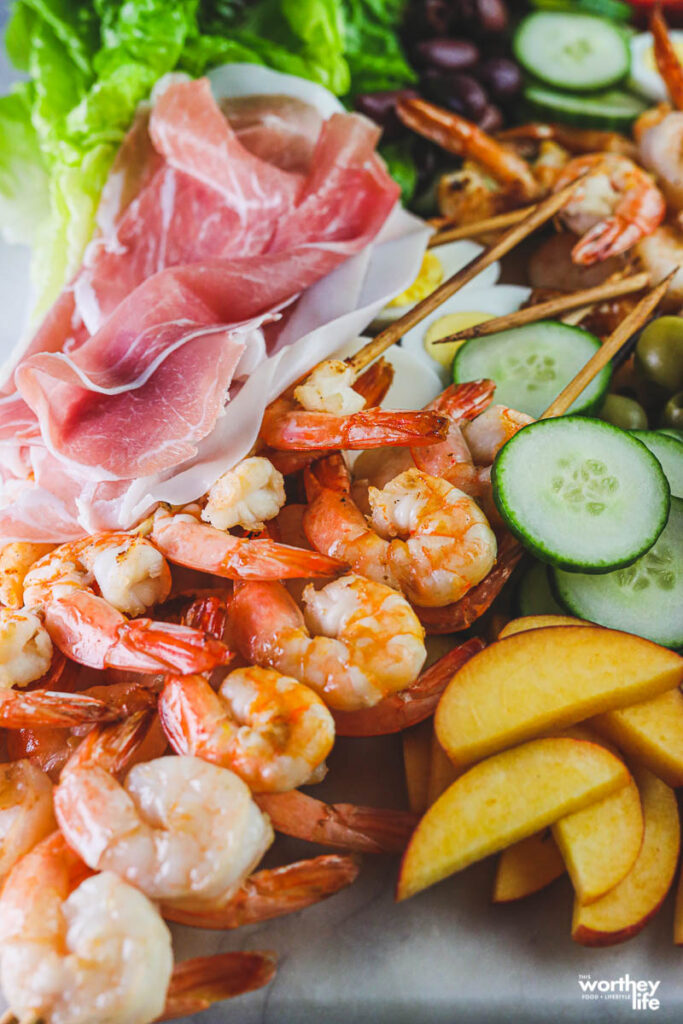
What is unique about a Samagundi board?
These boards are just great to have made up for parties, family gatherings, and more to snack on.
It offers a gorgeous presentation value and a wide arrangement of food to pick from, allowing everyone to find something they might enjoy eating.
The elegant presentation value is what wins people over.
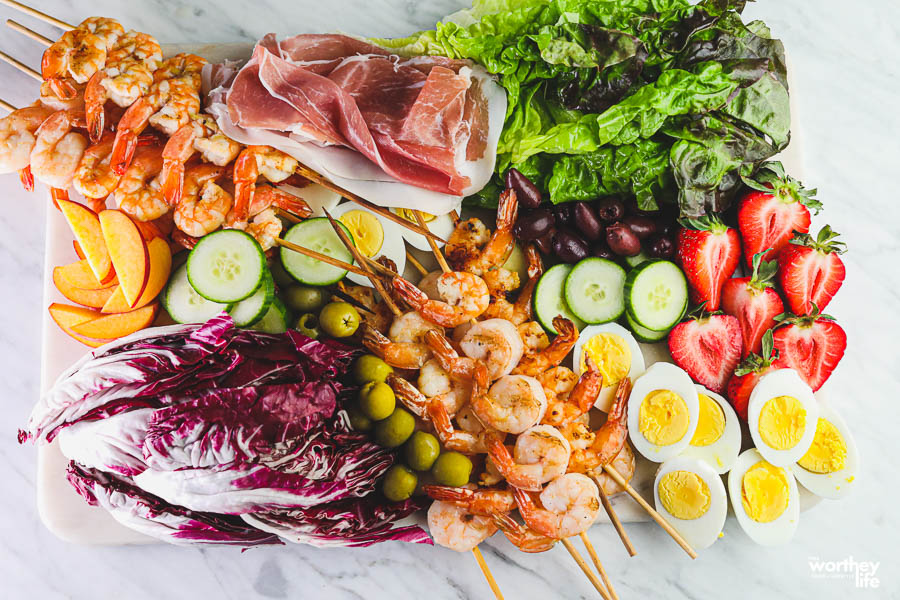
What are five tips for making a grazing board?
Size of Board. Make sure you reach for the right size board. The idea is to fill the whole board up with food.
So if you plan to serve many people, a larger board will be your best bet. Or, for a smaller gathering, reach for a smaller-sized board.
Fill The Space. When you are going to place the food on the board, it is important to work at filling all the space.
Smaller areas will use items like olives, fruit, and nuts to fill in the spaces.
Pre-sliced Food. Make sure that if you are using meats or cheese, you use pre-sliced food.
That way, guests can grab what they want without cutting the food themselves. It is easy to pick up and eat.
Variety In Food. The idea of this is to have an arrangement of food loaded with colors—Green, purple, red, etc.
The more contrast in colors, the more appealing your grazing board will appear.
Spread The Food Out. As you can see on our board, we created areas for each food item, keeping them together.
Depending on the size of your board, you may have room to have the same foods on the opposite end of the platter. That way, whether you are on the left or right side of the board, you can always reach the type of food you want. This is important if you are using a larger board.
What if I don’t have a serving board for the Salmagundi board?
Honestly, you can use any style of board you would like, even if it is a cutting board.
Or you could even grab a baking tray wrapped in foil or butcher paper.
It doesn’t have to be fancy; something simple works as well.
More recipes to try:
Breakfast Board For Busy Mornings
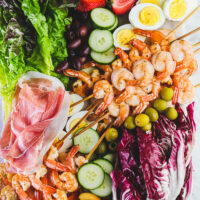
Ingredients
- 2 packages of prosciutto
- 1 head of oak leaf lettuce pulled apart or chopped
- 6 hard-boiled eggs then cut in half
- 20 shrimp five per skewer raw shrimp with the heads removed, or use precooked shrimp
- 1 cup of strawberries
- 1 large English cucumber cut into small rounds
- 1/2 cup pitted green olives
- 1/2 pitted black olives
- 1 stick of unsalted butter
- 2 tbsp of honey
- 3 cloves of garlic minced
- freshly cracked black peppercorns to taste
- sea salt to taste
Instructions
- Melt the butter and add honey and minced garlic. Set aside.
Devein the shrimp and remove the heads, slide the shrimp onto the wooden skewers.
Cook the shrimp on a stovetop grill pan or outdoor grill over medium-high heat, divide the butter mixture, baste the shrimp skewers with the prepared honey garlic butter, and season to taste with freshly cracked black peppercorns or sea salt. Serve the shrimp with the remaining honey garlic butter.
Boil eggs and allow them to cool; when eggs are safe to handle, cut them in half.
Place the hard-boiled eggs, shrimp skewers, and lettuce on a serving board.
Arrange the remaining prosciutto, strawberries, cucumbers, and green and black olives around the board.
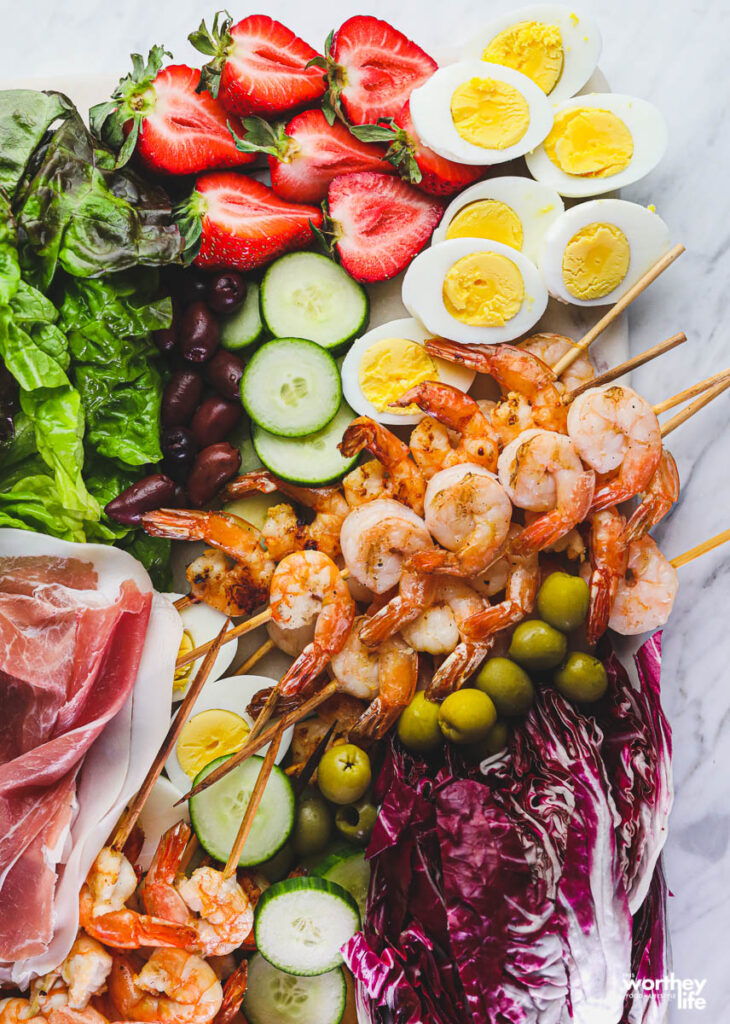
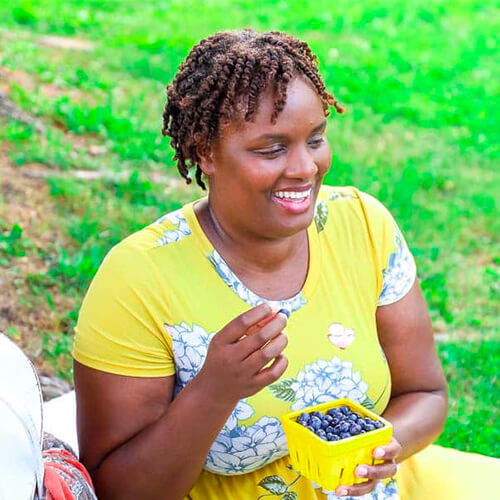

KG says
This is beautiful, thank you!
T Worthey says
Thank you so much!
Gary says
I was introduced to salmagundi at the 1850s restaurant in Greenfield Village, Dearborn, Michigan. I have yet to see a “charcuterie” as diverse. (Don’t forget the crostini and fig preserves.)